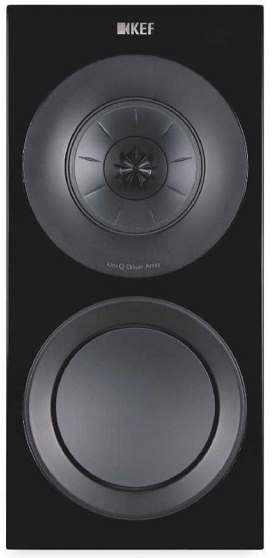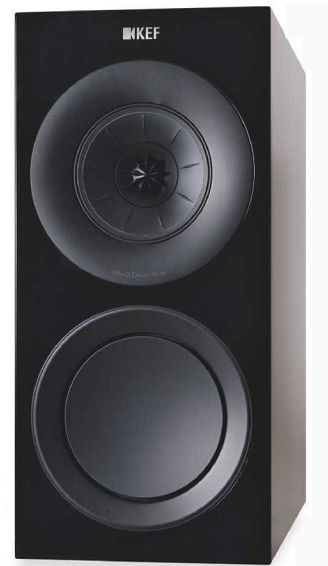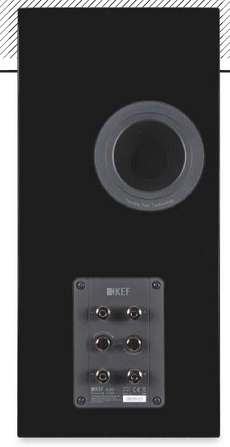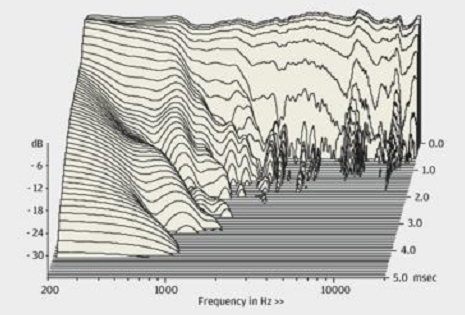KEF says 1000+ changes have gone into its new R Series, so how does this translate to the only standmount loudspeaker in the lineup? We listen to what the R3 has to say…Read our KEF R3 Review.
Review: James Parker
Lab: Keith Howard.
[wpsm_toplist]

Who needs shifts in the weather when you can judge the time of year by hi-fi launches?
Those of us who exist in the twilight world of hi-fi reviewing, and are strangers to Vitamin D, didn’t need a chill in the air and the first signs of yellowed leaves swirling around to know it was autumn – instead, a flurry of press releases announced new or revamped speaker ranges, as the big names prepared for another season of long evenings and hunkered-down listening.
This year Bowers & Wilkins kicked things off with its new entry-level 600 series [p64], closely followed by Wharfedale’s budget D300 models. Now comes KEF’s revamped R series, represented here by the only standmount in the range, the R3. Available in a choice of three finishes – light walnut as well as trendy black and white gloss – the speakers may look like familiar fare from Maidstone, but in fact are all-new, the company claiming no fewer than 1043 adaptations were made in creating the range.
NOT JUST A TRIM
Replacing the original R models, launched some seven years ago, involves not just new drivers, including the 12th generation of KEFs celebrated Uni-Q coaxial driver [see KH’s boxout, p51], but also a rethink of both enclosure and reflex ports, adopting technology from both the company’s Reference series and the acclaimed LS50 model [HFN Jul ‘ 12 & Oct ’17].
Six speakers make up the range, with three floorstanders sitting above the R3. The R5 is £ a pair, the R7 and the range-topping R11, while the ‘new R’ offering is completed with a dedicated centre speaker, the R2c, and upward-firing Dolby Atmos add-on speakers, the R8a. The wedge-shaped ‘effects’ speaker, designed to be used atop one of the other models or wall-mounted, is the only two-way design in the range,
‘NewBoots… is all sinuous bass-lines and rolling piano figures’
using a 13cm Uni-Q array complete with 25mm tweeter. All the other models combine the Uni-Q with at least one dedicated bass driver (or four in the case of the top-end R11).
In the R3, the Uni-Q solution is a 12.5cm unit, again with that 25mm tweeter at the centre, and this is backed up with a 16.5cm bass driver handling frequencies below about 400Hz. A common theme across all the latest R series speakers is the use of KEF’S ‘Shadow Flare’ surround on the Uni-Q driver, described as ‘more than just a trim ring… a precision-designed surface that extends the waveguide effect of Uni-Q. The tweeter no longer has line of sight of the cabinet edges, creating a “shadow region” at the points where the potential for diffraction is highest, minimising the acoustic impact to negligible levels’.
Derived from the company’s Reference Series speakers, this gently contoured surface around the Uni-Q driver is said to improve clarity, particularly ‘when it comes to the subtle nuances of plucked strings and percussive sounds’.
The bass driver, meanwhile, uses a diaphragm of two-part construction, combining a shallow concave aluminium layer over a paper cone to add stiffness, while the design is said to reduce resonances, enhance pistonic movement and thus reduce distortion. The motor system has also been redesigned to achieve a more uniform magnetic field.
Constrained layer damping, originally conceived for the LS50, and a new approach to bracing, combine here to help ‘dial out’ the effect of the cabinet on the sound. Furthermore, the flexible port tubes are the result of computer modelling and extensive auditioning, and the crossovers are mounted on separate boards that are decoupled from the main cabinet structure to reduce vibration effects.
UNDER THE GRILLES
Read deeper into the design of the R series and you uncover some more of those ‘1000+ changes’, though I must admit I did skimp a bit when it came to counting them all as part of this review! Worthy of note, however, is the quality of the microfiber grilles supplied with the speakers, so often a ‘leave them in the box’ thing for reviewers. The R3’s grilles don’t just attach magnetically, for a clean look when removed – more or less a given these days – but are of a 13-layer construction giving a high quality finish, and with what I am told are ‘1801 precision-cut holes for each driver’, arranged in a circular pattern over each unit.
It was notable that the effect of fitting these grilles, which in other designs can bring some softening of the sound, was inaudible.
With the grilles off, you’ll also find that the skills gained in making some of the brightly- coloured driver finishes found elsewhere in the company’s range – notably in the LS50s, Blade and the ‘Foundry Edition’ variants of the Reference series – are used to more subtle effect here, by colour-keying the drivers to match the cabinet finish chosen. It’s an unusual but very effective detail, as is the fact that the grilles are also toned to match the cabinets – in grey for the white model and brown for the walnut, plus of course black for the gloss black speakers.
FOCUSED ’N’ REFINED
The R3 isn’t the smallest of standmount speakers, at some 42cm tall, but it doesn’t look excessively large when used on KEF’s matching stands, which are available in a choice of black, grey or white. What’s more, the R3 is a relatively unfussy design when it comes to both positioning and partnering equipment. I ended up with the speakers around half a metre away from side and rear walls, with a slight toe-in to the listening position to firm up the image. Even with them pushed well back, the bass remained controlled and well-defined.
Like all the best speakers, these KEFs get better as you up the ante on the source and amplification front, but they’re happy enough being driven by modest amps if that’s all you have. I had good results with both the slightly restrained Arcam SA10 and the sparkier Pioneer A-40AE [HFN Aug ’ 18] at the lower end of the price scale, while the speakers really thrived on the end of my usual Naim set-up, as well as with the storming Parasound Halo JC5 power amp [p68] – which might just be seen as slightly OTT for a £1300 pair of speakers!
A feeling of precision is the most obvious first impression of the R3, with clear, focused soundstaging and excellent resolution of voices and instruments alike. But all this is underpinned with bass that’s both weighty and well-controlled, with no sense of lack of extension and not a hint of overwrought upper bass being employed to hide any deficiencies lower down.
Instead the R3 is all about balance and a totally ‘together’ presentation of the music, enhanced by the excellent imaging that’s almost a Uni-Q tech trademark.
That means the speakers make the most
[wpsm_titlebox title=”12TH GEN UNI-Q” style=”main”]
It was the arrival of high-strength neodymium-iron-boron magnets which. 30 years ago, allowed KEF to place a dome tweeter where a cone driver’s dust cap would conventionally be, thereby creating its first Uni-Q coaxial driver (which KEF today refers to as an array). The Uni-Q driver in the new R series is a 12th-generation design, and comparison with photos of the 1988 original indicates how much has changed. The principal benefit of Uni-Q is to directivity: it removes the off-axis ‘lobing’ at crossover that occurs with drivers having physically displaced acoustic centres, and it allows the directivity of the midrange and treble output to be matched at crossover, avoiding a step-change.
KEF long ago solved the problem of treble unevenness resulting from hornlike reflections at the ‘mouth’ of the cone diaphragm by paying meticulous attention to the profile of the cone and its surround. A new refinement, inherited from the Reference series, is the use of a compliant joint between the midrange driver’s voice coil and aluminium cone which helps control breakup resonances above the passband.[/wpsm_titlebox]
of the live presence of the That Hot Pink Blues Album by Keb’ Mo’ [Kind of Blue Music KOBL 41475], while displaying a deft touch with the rhythms and, of course, the guitar and voice, all wrapped in a warmth and generosity that makes the set so easy to enjoy. There’s no softness or restraint here – rather the speakers are allowing the atmosphere of the recording to come through.

NOSE TO NOSE
They do the same with the unashamed roughness of Ian Dury & The Blockheads’ New Boots And Panties!!, being especially persuasive with the stripped-down demo versions on the 2015 Edsel two- disc re-release [EDSK 7080], which get closer to Dury’s voice and the instruments. The alternative version of ‘Sex & Drugs & Rock & Roll’ is all sinuous bass-lines and rolling piano figures, and these show the control and speed of the R3s extremely well.
That same combination of rhythmic acuity and tightly controlled detail also serves well the new Paul Weller set, True Meanings [Parlophone 0190295615161]- even on tracks such as ‘Clide’ where the vocal recording is ‘intimate’ and Weller seems to be nose to nose with the listener.

The lushness of the mixes on this album means the sound is often extremely dense, but the R3s, especially on the end of sprightly amplification, make a fine job of opening things up so one can listen in rather than simply letting it all wash across the room.
It’s no surprise, therefore, that the R3 speakers are fast and vibrant with the latest set from Scandi- jazzers Phronesis, We Are All [Edition Records EDN1118]. Here Jasper Holby’s bass is at once sonorous and tight, while Ivo Neame’s piano combines body and lightness of touch, and Anton Eger’s drumming is revealed with all its invention intact.
Indeed, while these new KEFs have the weight and speed to rock, they’re at their most persuasively sparkling with well-recorded instruments, as is dear when Anna Fedorova blasts through the final section of Beethoven’s ‘Moonlight’ Sonata on her Four Fantasies album [Channel Classics CCS41318; DSD 128], The performance has no shortage of attack, and yet the speakers allow every note from the Steinway piano to be heard and enjoyed, bathed in the spacious acoustic of the concert-hall space.
Verdict
The R3 isn’t without competition in this sector of the market, with models such as the Spendor A1, Monitor Audio Gold 100 and B&W 706 S2 breathing the same sort of air, but it distinguishes itself with precision and control, plus the ability to have a good time. The many improvements made have built on long-standing KEF strengths, in particular the imaging from that Uni-Q driver and the quality of the bass.
LAB REPORT – KEF R3
The days are long gone when KEF”s Uni-Q coaxial drivers had an uneven treble output because of less-than-perfect loading of the central tweeter by the waveguide formed by the midrange cone. For evidence, look no further than the R3’s forward frequency responses [Graph 1, below], measured at 1m on the Uni-Q axis. The response errors are ±2.0dB and ±2.1dB respectively – remarkably, a tad better than we measured from the DSP-active Kii Three over the same 200Hz-20kHz [HFN Aug ’18], although the R3 cannot match the latter’s stunning ±1.1dB below 12kHz. The R3 also just betters the Three’s pair matching error at ±0.7dB over the same frequency range, albeit not its unprecedented ±0.3dB below 15kHz. In short, the R3’s frequency response is amazingly flat for a passive design – flatter than that of the ELAC Adante AS-61 (±3.3dB) which it superficially resembles [HFN Feb ’18).
The R3 also betters the AS-61 for sensitivity (86.1 dB versus 83.4dB) and slightly for bass extension too (40Hz versus 46Hz, -6dB re. 200Hz), although the R3’s LF output is shelved down by about 6dB below 100Hz until rolling off rapidly below 40Hz. Low impedance is exploited to achieve this: the R3’s 3.1 ohm minimum modulus making it a true 4ohm design, while its phase angles drive the EPDR (equivalent peak dissipation resistance) down to a low of 1,S ohm at 39Hz, with another dip to 2.2ohm at 226Hz. So the R3 is demanding of its amplifier! Another indication of how skilfully KEF has contrived the cone flare and surround design to prevent treble reflections without paying the price of compromised bending stiffness is the CSD plot [Graph 2],

ABOVE: The R3 boasts a remarkably flat and extended response for a passive loudspeaker of limited size

ABOVE: Cabinet, bass and Uni-Q drivers are also well controlled with v. mild modes just visible in the treble
KEF R3 SPECIFICATIONS
[wpsm_colortable color=”blue”]
| Sensitivity (SPL/1m/2.83Vrms – Mean/IEC/Music) | 86.1 dB/ 86.1dB/ 86.1dB |
| Impedance modulus min/max (20Hz-20kHz) | 3.1 ohm @ 44Hz 13.1 ohm @ 2.4kHz |
| Impedance phase min/max (20Hz-20kHz| | -42” @ 37Hz |
| Pair matchlng/Response Error (200Hz-20kHz) | ±0.7dB/ ±2.0dB/±2.1dB |
| LF/HF extension (-6dB ref 200Hz/10kHz) | 40 HZ / >40 kHz/ >40 kHZ |
| THD 100Hz/ 1kHz/ 10 kHz (for 90dB SPL / 1m) | 0.5% / 0.2% / 0.1% |
| Dimensions (HWD) / Weight (Each) | 421x200x312mm / 14kg |
[/wpsm_colortable]

Great review! Please make the response graphs (1 & 2) larger or able to open full size in another window. Also a direct comparison with a graph of an LS50’s frequency response would also be helpful.
Thanks for your feedback. I updated the response graphs. <3
Hi, none of the images are loading; the links seem to be broken. Could you please check the images?
Thanks!
Hi Daniel,
thanks for your information. The images are normal when I accessing this post. Could you tell me which browser and operation that you used ?
Or may be the errors come from this website’s hosting provider. Can you please help me recheck ?
haven’t purchased speakers in over a decade. I have the LSA 1 Statement Monitors which is no longer in business but they have reproduced music phenomenally for all my Jazz, rock and roll and acoustic music. I have a Pass XA 30,5 amp also magical with my source being either an old Cary DVD 7 CD player. I also play through Sonos from time to time. At around $2000-2750 which is what I have to spend, would these or something else be a big improvement?
Thanks
Drew
Whats the frequncy response in relation to a similar speaker?
I used KEF R3’s with my Accuphase e-380, Chord Qutest DAC & LUMIN U20 Mini streamer audioquest rocket 88’s speaker and Nordost Red Dawn analog to amp and Nordost Tyre 2 digital cable 3′ simply breathtaking soundstage.